Taishin Financial Holdings Bundle
Who Really Owns Taishin Financial Holdings?
Understanding the ownership structure of a financial powerhouse like Taishin Financial Holdings is crucial for any investor or strategist. The recent merger approval with Shin Kong Financial Holding Co. in October 2024 signals significant shifts in the Taiwanese financial landscape. This strategic move reshapes the competitive dynamics, making it essential to understand who controls Taishin and what their vision entails.
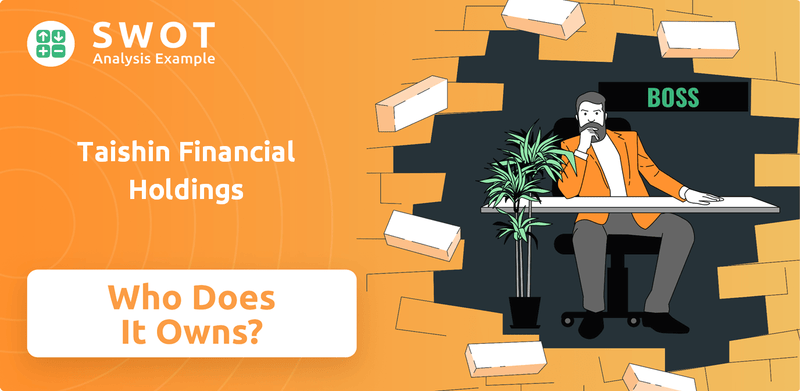
Founded in 2002, Taishin Financial Holdings is a prominent Taiwanese financial holding company with a market capitalization of $7.22 billion as of June 2025. Exploring Taishin ownership reveals insights into its strategic direction and future prospects, especially in light of its expansion plans and Taishin Financial Holdings SWOT Analysis. This exploration of Taishin shareholders and corporate structure will provide a comprehensive understanding of this key player in the Taiwanese financial market, including the impact of major shareholders and the company's financial performance.
Who Founded Taishin Financial Holdings?
Taishin Financial Holding Co., Ltd. was established in 2002, but its roots trace back to 1992 with the founding of Taishin International Bank. The driving force behind this venture was Thomas T.L. Wu, son of Hos-Hui Wu, who came from a prominent Taiwanese textile family. His vision was to create a leading financial group in the Chinese-speaking world.
The early stages of Taishin Financial Holdings involved the strategic integration of various financial services under one umbrella. This move was aimed at offering a comprehensive suite of services, including banking, securities, and investment advisory, to cater to a wide range of customer needs. The establishment of the financial holding company structure in 2002 was a key step in this direction.
The initial ownership structure of Taishin Financial Holdings was not publicly detailed, but Thomas Wu's leadership was central. The early backing likely came from his family's resources and his entrepreneurial drive. The company's formation as a financial holding company was a strategic decision to integrate different financial services, aiming to provide comprehensive and marketable services.
The primary goal was to build a 'Top Chinese Financial Group'. This aimed at offering a broad array of financial services to customers.
Early financial support likely came from Thomas Wu's family background. His entrepreneurial spirit was key to entering the financial sector.
The financial holding company structure integrated various financial services. This included banking, securities, and investment trusts.
The aim was to provide well-rounded and marketable services. This was a key element of the founders' vision.
The financial holding company structure was a strategic move. This aimed to integrate different financial services.
Details of initial shareholdings were not publicly available. Thomas Wu's leadership was central to the company's establishment.
Understanding the history of Taishin Financial Holdings' competitors can provide additional insights into its market position.
- Taishin ownership structure evolved over time, reflecting changes in the financial landscape.
- The early focus was on providing comprehensive financial solutions. This approach aimed to serve a broad customer base.
- The company's establishment as a financial holding company was a strategic move. This facilitated the integration of various financial services.
- The initial backing came from Thomas Wu's family and his entrepreneurial drive. This was crucial for entering the financial sector.
Taishin Financial Holdings SWOT Analysis
- Complete SWOT Breakdown
- Fully Customizable
- Editable in Excel & Word
- Professional Formatting
- Investor-Ready Format
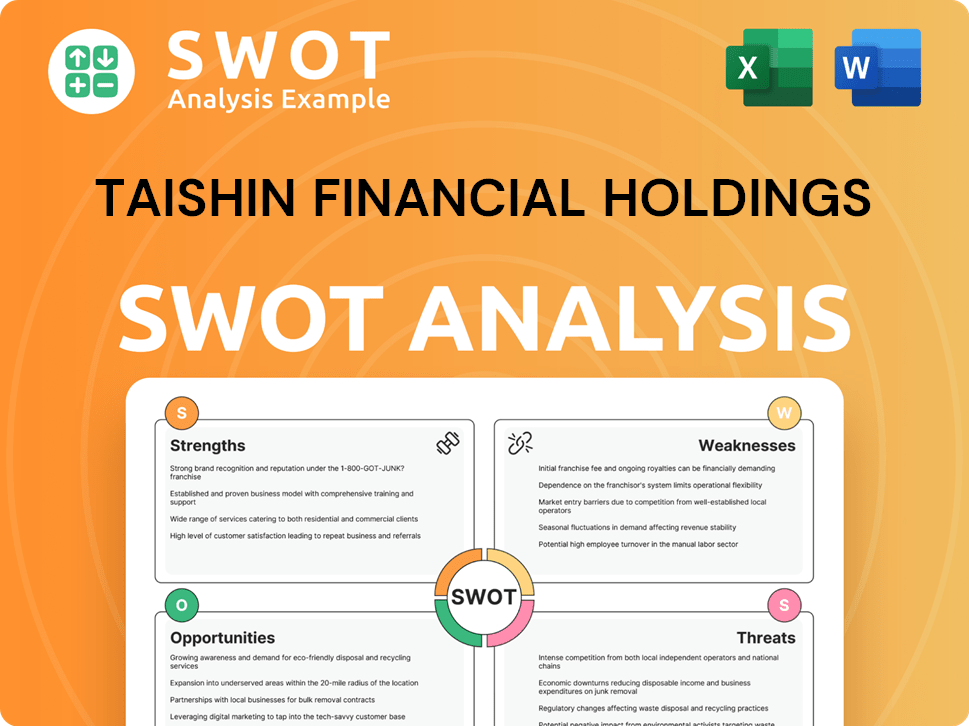
How Has Taishin Financial Holdings’s Ownership Changed Over Time?
The evolution of Taishin Financial Holdings' ownership structure reflects its journey as a leading Taiwanese financial institution. Initially, the company was privately held, but it transitioned to a publicly traded entity, significantly altering its shareholder base. This shift introduced a mix of institutional and individual investors, shaping the company's corporate structure and strategic direction. The primary keywords here are Taishin Financial Holdings, Taishin ownership, and Taishin shareholders.
The company's market capitalization as of June 11, 2025, stands at approximately $7.22 billion, with roughly 13 billion shares outstanding. This provides a snapshot of the company's current valuation and the scale of its publicly traded shares. Major stakeholders include institutional investors like Yuanta Securities Investment Trust Co., Ltd., The Vanguard Group, Inc., and BlackRock Fund Advisors. Understanding the ownership structure details is crucial for anyone interested in Taishin Financial Holdings.
| Shareholder | Percentage of Ownership (as of) | Notes |
|---|---|---|
| Yuanta Securities Investment Trust Co., Ltd. | 3.75% (June 6, 2025) | A significant institutional investor. |
| The Vanguard Group, Inc. | 2.60% (June 4, 2025) | A notable institutional investor. |
| BlackRock Fund Advisors | 2.17% (June 5, 2025) | Another key institutional investor. |
| Norges Bank Investment Management | 1.14% (June 30, 2024) | Holds a considerable stake. |
| Tai-Ho Enterprise Investment Co. Ltd. | 3.898% | A significant shareholder. |
| State Street Global Advisors Ltd. | 0.1721% | A notable shareholder. |
A pivotal event impacting Taishin's ownership is the proposed merger with Shin Kong Financial Holding Co., Ltd. Approved by shareholders in October 2024, this merger aims to create Taiwan's fourth-largest financial holding company. The merger involves Taishin Financial issuing new shares in exchange for Shin Kong Financial shares, with Taishin Financial being the surviving entity. This consolidation is expected to expand market share and business scale across banking, securities, and insurance, potentially reshaping the landscape of Taiwanese financial institutions.
Taishin Financial Holdings' ownership structure is a blend of institutional and individual investors.
- Major shareholders include Yuanta Securities, The Vanguard Group, and BlackRock.
- The merger with Shin Kong Financial will significantly alter the company's size and market position.
- The company's market capitalization is approximately $7.22 billion as of June 11, 2025.
- This consolidation is expected to expand market share and business scale across banking, securities, and insurance.
Taishin Financial Holdings PESTLE Analysis
- Covers All 6 PESTLE Categories
- No Research Needed – Save Hours of Work
- Built by Experts, Trusted by Consultants
- Instant Download, Ready to Use
- 100% Editable, Fully Customizable
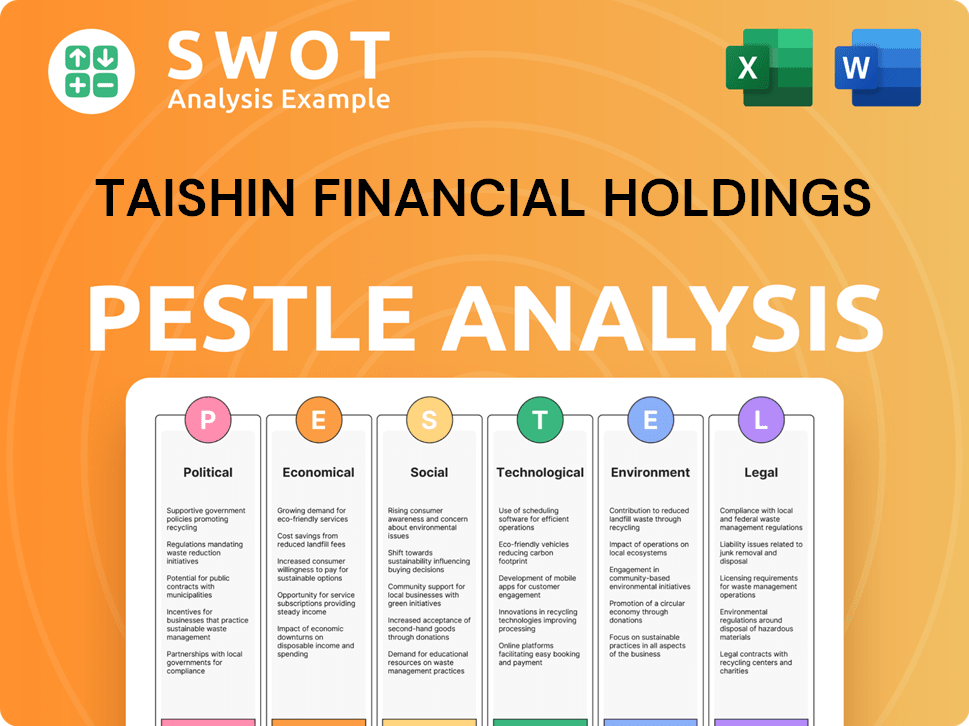
Who Sits on Taishin Financial Holdings’s Board?
The Board of Directors of Taishin Financial Holding Co., Ltd. oversees the company's strategic direction. The current board, elected on June 14, 2024, for a term from July 1, 2024, to June 30, 2027, comprises seven members, including three independent directors. Thomas T.L. Wu serves as Chairman, representing Chia Hao Co., Ltd. Other directors include Wu Cheng-Ching and Kuo Jui-Sung. The independent directors are Kuo-Lin Kuan, Wang Mei-Hua, and Min-Yu Chang. Understanding the Marketing Strategy of Taishin Financial Holdings is crucial to understanding the company's overall performance.
The composition of the board reflects Taishin's corporate structure and its commitment to governance. The presence of independent directors ensures a degree of impartiality in decision-making, which is vital for the company's long-term stability and stakeholder trust. The cumulative voting method used in director elections allows shareholders to concentrate their votes, potentially influencing the board's composition.
| Director | Representative | Role |
|---|---|---|
| Thomas T.L. Wu | Chia Hao Co., Ltd. | Chairman |
| Wu Cheng-Ching | TASCO Chemical Co., Ltd. | Director |
| Kuo Jui-Sung | Hsiang-Chao Co., Ltd. | Director |
| Kuo-Lin Kuan | Independent | Independent Director |
| Wang Mei-Hua | Independent | Independent Director |
| Min-Yu Chang | Independent | Independent Director |
The history of Taishin Financial Holdings includes significant governance challenges, particularly concerning its control over Chang Hwa Commercial Bank (CHB). This case highlighted the complexities of Taishin ownership and the influence of government entities in Taiwanese financial institutions. The ongoing dispute, which began in 2005, underscores the importance of understanding voting power and corporate governance in the context of financial holding companies.
The board's composition and election process are vital for Taishin's governance. The cumulative voting system impacts how Taishin shareholders can influence board decisions.
- The board includes both executive and independent directors.
- The election system allows shareholders to concentrate their votes.
- Historical disputes highlight the impact of ownership structure.
- Understanding the board is key to understanding Taishin's direction.
Taishin Financial Holdings Business Model Canvas
- Complete 9-Block Business Model Canvas
- Effortlessly Communicate Your Business Strategy
- Investor-Ready BMC Format
- 100% Editable and Customizable
- Clear and Structured Layout
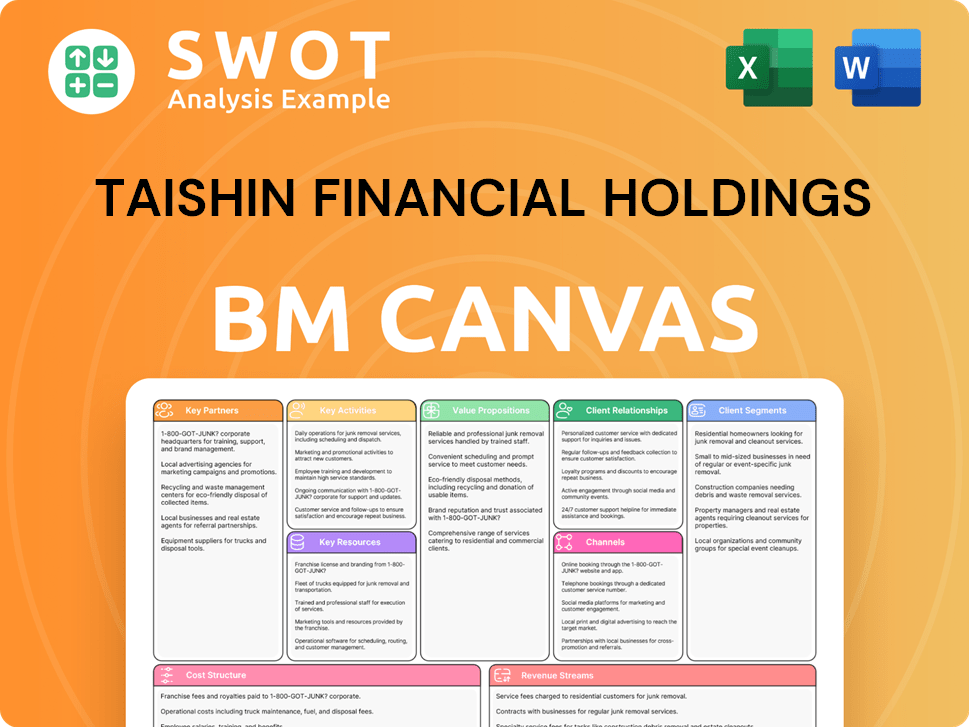
What Recent Changes Have Shaped Taishin Financial Holdings’s Ownership Landscape?
Over the last few years, Taishin Financial Holdings has seen significant shifts in its ownership structure and strategic direction. A major development is the approved merger with Shin Kong Financial Holding Co., Ltd., which received regulatory approval on March 31, 2025. The effective date is set for July 24, 2025, with the consolidation of major subsidiaries expected within two years. This merger is projected to establish Taishin Financial Holdings as Taiwan's fourth-largest financial holding company, boosting its market share across banking, securities, and insurance.
In terms of Taishin ownership trends, the financial sector in Taiwan, and globally, has witnessed increased institutional ownership and strategic consolidations. Major institutional shareholders include Yuanta Securities Investment Trust Co., Ltd., The Vanguard Group, Inc., and BlackRock Fund Advisors. Foreign investors have also been active; in September 2024, the company was among the most oversold securities by foreign investors. For more information, you can check out the Target Market of Taishin Financial Holdings.
| Shareholder | Type | Approximate Ownership |
|---|---|---|
| Yuanta Securities Investment Trust Co., Ltd. | Institutional | Data not available |
| The Vanguard Group, Inc. | Institutional | Data not available |
| BlackRock Fund Advisors | Institutional | Data not available |
The company continues to integrate its subsidiaries and expand its services. For example, in August 2020, the board resolved to merge Prudential Life Insurance of Taiwan Ltd., which was approved by the FSC in June 2021 and renamed Taishin Life Insurance. Leadership changes, such as the announcement on June 12, 2025, of a new CEO for Taishin Bank's Wholesale Banking Group, signal a strategic push towards comprehensive financial solutions and market leadership.
The merger with Shin Kong Financial Holding Co., Ltd. is set to significantly increase Taishin's market share and business scale.
Major institutional investors like Yuanta Securities and BlackRock hold substantial stakes in the company.
Taishin Financial Holdings is focused on integrating subsidiaries and expanding service offerings.
Recent leadership changes and acquisitions highlight the company's strategic drive.
Taishin Financial Holdings Porter's Five Forces Analysis
- Covers All 5 Competitive Forces in Detail
- Structured for Consultants, Students, and Founders
- 100% Editable in Microsoft Word & Excel
- Instant Digital Download – Use Immediately
- Compatible with Mac & PC – Fully Unlocked
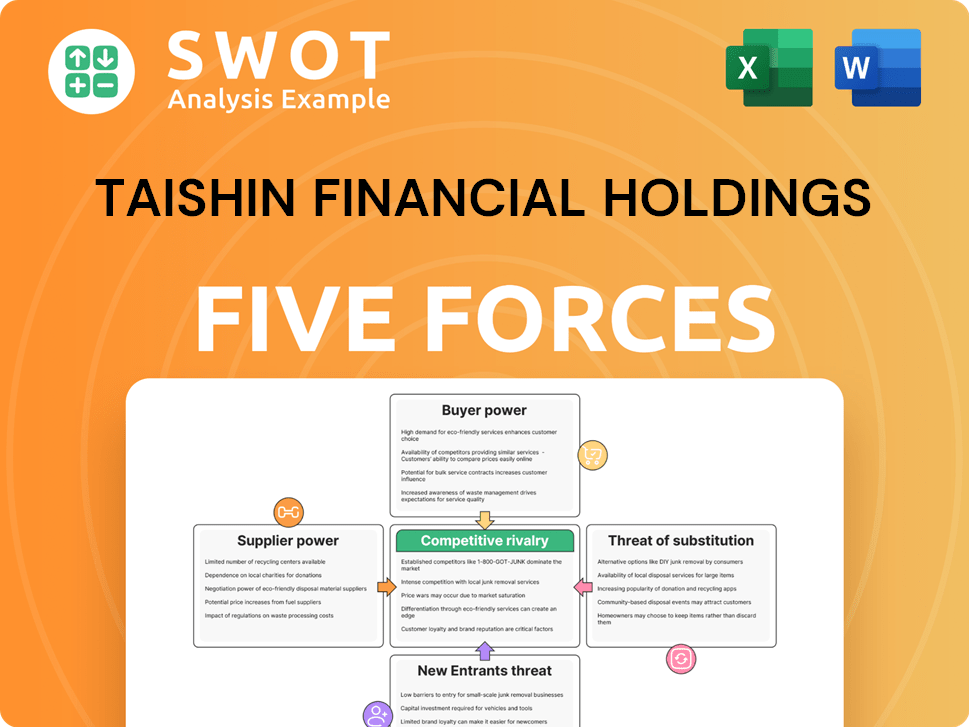
Related Blogs
- What are Mission Vision & Core Values of Taishin Financial Holdings Company?
- What is Competitive Landscape of Taishin Financial Holdings Company?
- What is Growth Strategy and Future Prospects of Taishin Financial Holdings Company?
- How Does Taishin Financial Holdings Company Work?
- What is Sales and Marketing Strategy of Taishin Financial Holdings Company?
- What is Brief History of Taishin Financial Holdings Company?
- What is Customer Demographics and Target Market of Taishin Financial Holdings Company?
Disclaimer
All information, articles, and product details provided on this website are for general informational and educational purposes only. We do not claim any ownership over, nor do we intend to infringe upon, any trademarks, copyrights, logos, brand names, or other intellectual property mentioned or depicted on this site. Such intellectual property remains the property of its respective owners, and any references here are made solely for identification or informational purposes, without implying any affiliation, endorsement, or partnership.
We make no representations or warranties, express or implied, regarding the accuracy, completeness, or suitability of any content or products presented. Nothing on this website should be construed as legal, tax, investment, financial, medical, or other professional advice. In addition, no part of this site—including articles or product references—constitutes a solicitation, recommendation, endorsement, advertisement, or offer to buy or sell any securities, franchises, or other financial instruments, particularly in jurisdictions where such activity would be unlawful.
All content is of a general nature and may not address the specific circumstances of any individual or entity. It is not a substitute for professional advice or services. Any actions you take based on the information provided here are strictly at your own risk. You accept full responsibility for any decisions or outcomes arising from your use of this website and agree to release us from any liability in connection with your use of, or reliance upon, the content or products found herein.